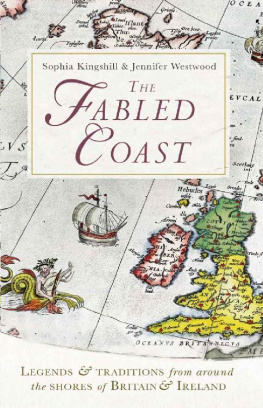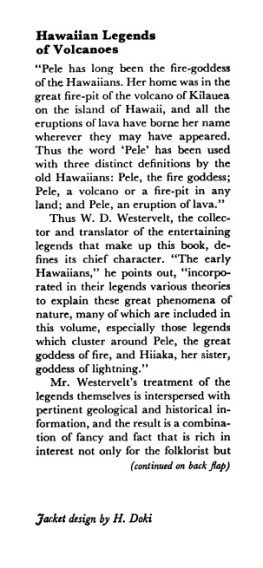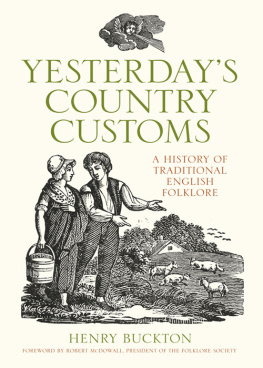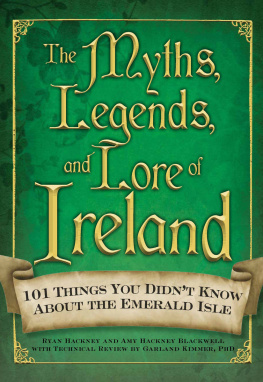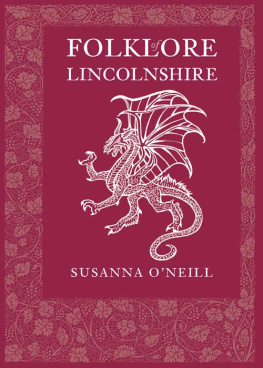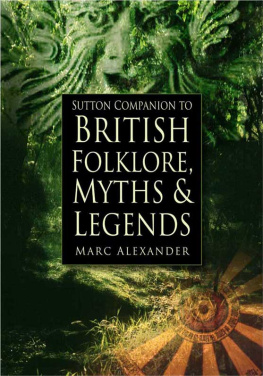CONTENTS
Channel Islands, Cornwall, Devon, Dorset, Gloucestershire, Scilly Isles, Somerset
Hampshire, Kent, London, Sussex, Isle of Wight
Essex, Norfolk, Suffolk
County Durham, Lincolnshire, Northumberland, Tyne & Wear, Yorkshire
Cheshire, Cumbria, Lancashire, Isle of Man, Merseyside
Isle of Anglesey, Bridgend, Cardiff, Carmarthenshire, Ceredigion, Conwy, Gwynedd, Newport, Pembrokeshire, Swansea, Vale of Glamorgan
Aberdeenshire, Argyll & Bute, Ayrshire, Dumfries & Galloway, East Lothian, Fife, Inverclyde, Moray, Scottish Borders
Highland, Orkney, Shetland, Western Isles
Counties Antrim, Donegal, Down, Galway, Louth, Mayo, Meath, Sligo
Counties Clare, Cork, Dublin, Kerry, Waterford, Wexford
About the Book
Pirates and smugglers, ghost ships and sea-serpents, fishermens prayers and sailors rituals the coastline of the British Isles plays host to an astonishingly rich variety of local legends, customs, and superstitions.
In The Fabled Coast, renowned folklorists Sophia Kingshill and Jennifer Westwood gather together the most enthralling tales and traditions, tracing their origins and examining the facts behind the legends. Was there ever such a beast as the monstrous Kraken? Did a Welsh prince discover America, centuries before Columbus? What happened to the missing crew of the Mary Celeste? Along the way, they recount the stories that are an integral part of our coastal heritage, such as the tale of Drakes Drum, said to be heard when England was in peril, and the mythical island of Hy Brazil, which for centuries appeared on sea charts and maps to the west of Ireland. The result is an endlessly fascinating, often surprising journey through our island history.
About the Authors
SOPHIA KINGSHILL is the author of a previous book with Jennifer Westwood, The Lore of Scotland, which was published by Random House in 2009. She also writes for the theatre, and her plays have been performed in Scotland, England, and Norway.
JENNIFER WESTWOOD was born in 1940 and studied English Language at Oxford, followed by Medieval Icelandic at Cambridge. A long-time member of the Folklore Society, she served as editor of FLS Books and also the journal Folklore. Her books include Albion: A Guide to Legendary Britain (1985), Gothick Cornwall (1992), Lost Atlantis (1997), On Pilgrimage (2003), The Lore of the Land (2005, with Jacqueline Simpson), and The Lore of Scotland (2009, with Sophia Kingshill). When she died in 2008, she left a wealth of material for her most cherished project, a collection of British sea and coastal legend, which is embodied in this book.
The Fabled Coast
LEGENDS & TRADITIONS
FROM AROUND THE SHORES
OF BRITAIN & IRELAND
Sophia Kingshill &
Jennifer Westwood
To Jane Kingshill (19232012)
ACKNOWLEDGEMENTS
This book is based very largely on material compiled by the late Jennifer Westwood, outstanding folklorist and my much-missed friend. She was generous enough to bequeath me her wide-ranging research into sea-lore, and the process has been truly a collaboration, to the point where I would find it hard to sort out what is my writing from what is hers. I hope the result falls not too far short of her breathtakingly high standards.
Neither Jennifer nor I could have got anywhere without the pioneering work of other writers. Fletcher Bassetts Legends and Superstitions of the Sea and of Sailors in all Lands and at all Times (1885), although not perhaps so literally comprehensive as its title suggests, is nonetheless an astounding compendium, and Wilbur Bassett, Fletchers son, examines several legends in meticulous and absorbing detail in his Wander-Ships (1917). The Broad, Broad Ocean (1871) and Credulities Past and Present (1880), by William Jones, provide fascinating material, while Walter Gills Manx Scrapbook (1929) and Second Manx Scrapbook (1932) have interest far beyond the shores of Man.
Of more recent works, David Thomsons People of the Sea (1954), which provided a majority of the seal legends, is remarkable literature in its own right. Gwen Benwell and Arthur Waughs Sea Enchantress (1961) is the most wide-ranging of investigations into the mermaid legend, and no book involving sea-monsters, Krakens and the like could be attempted without consulting Bernard Heuvelmanss In the Wake of the Sea-Serpents (translated by Richard Garnett, 1968). Peter Ansons Fisher Folk-Lore (1965) has been a wonderful resource. Horace Becks Folklore and the Sea (1973) is compulsively readable and endlessly entertaining, while Peter Kemps Oxford Companion to Ships and the Sea (1976) is indispensable.
Many newer and much older authors have gone into the mix, far too many to list here, but I have to credit two in particular whose scholarship and imagination have revived me when I felt I couldnt stand another mermaid whispering in my ear. John Livingston Lowess Road to Xanadu (1927) was a revelation not just for a Coleridge-lover and Dith hgins Lore of Ireland (2006), as well as several of his other books, opened up a world of poetry, history, implication and elucidation.
Friends and colleagues have helped me in more ways than I can mention. Brian Chandler, Jennifer Westwoods husband, has been endlessly supportive, as have my editors at Random House, Gemma Wain (who has put in much detailed and extremely valuable work on the text) and Sophie Lazar, and Nigel Wilcockson, to whom Jennifer owed her association with the company.
Jacqueline Simpson has indexed the entire book, as well as providing wise encouragement. Janet Bord and Tristan Gray Hulse put me right about several Welsh questions, and any mistakes that remain are my own alone. Jeremy Harte was his usual inspiring self, and also put me in touch with Richard Freeman of the Fortean Society, who was kind enough to read through a whole draft, and commented most helpfully. Paul Cowdells article on cannibal ballads contributed very largely to my own essay on survival cannibalism, and on the topic of monkey-hanging I have called on the expertise of Sandy Hobbs. I am grateful to the journal Folklore for permission to use material from my article on the Tobermory galleon, and in particular to Deborah East, Jessica Hemming, and Caroline Oates for their help in sorting this out.
For miscellaneous assistance and advice, I should like to thank particularly Frances Collinson, Chris Denton, Nick Dyer, Alan Griffiths, Gisela Holfter (and her helpful and knowledgeable friend Tadhg hIfearnin), Suzi Hopkins, Martin Morgan, Sophie Reissner, June Rose, Geoffrey Sample, Ann Shearer, Chris Sheffield, and my own family. Graeme Rosie has been forbearing and discreetly appreciative throughout.
Most importantly, I am grateful to Kristina Rapacki, picture researcher of genius, and to Clare Graydon-James, who tirelessly and cheerfully pursued queries with vicars, museum curators, and other authorities, and produced wonderful results. Not all the entries she investigated could ultimately be included in the book, for reasons of space, and I have to thank several kind informants whose contributions do not appear, as well as those whose do. They are, in alphabetical order: Reverend Peter Blackett, St Michaels church, Bowness-on-Solway; Sara Brown, Cambridge and County Folk Museum; Dr David Caldwell, Edinburgh Museum; Christina Carson, St Just Library; Lionel Clauzon, Newport Reference Library; the staff of the Cornish Studies Library; Rebecca David, Boscastle Tourist Information Centre; Peter Drummond, Orkney Museum; Sam Ellis, Scilly Isles Tourist Information Office; Katherine Fetherstonhaugh, Colwyn Bay Library; Howie Firth, Orkney Science Museum; Julian Gaisford-St Lawrence, Howth Castle; Graham Groom, Lockerby Library; Reverend Helen Griffiss, All Saints church, Mudeford; Father Milo Guiry, St Declans church; Paddy Hodgins, Seamus Roe and Sandra & Bryan Rogers, Clogherhead Historical Society; Mairi Hunter and Ruth Airley, Ewart Library, Dumfries; Alison Kentuck, Receiver of Wrecks; Diana Leake, Bridport Library; Diane Leggett, Local Studies Centre, North Shields Library; Anne Lenihan, Dungarvan Central Library; Florence Luscombe, St Ives Library; Reverend Donald MacEwan, St Monans church; Clare McIntyre, National Museums of Scotland; Jessie McKerrow, Middlebie church; John Mudge, Steeple Woodlands Nature Reserve; Mike Murphy, St Ives Archive; David Muscat, Colchester Library; Micheal O Coileain, Kerry County Council; Norma OMeara, Dungarvan Tourist Information Centre; Richard Parkinson, British Museum; Una Rowan, Cushendall Development Office; Reverend Ronald Seaman, formerly Dornock parish church, and Jeannette Seaman; Anne Sharp, Local Studies Centre, South Shields Library; the staff of the Shetland Library; Joe Smedley and Alison Burgess, Ewart Library, Dumfries; Reverend Hugh Steele, Dornock parish church; Reverend Robert Thewsey, Forrabury church.

